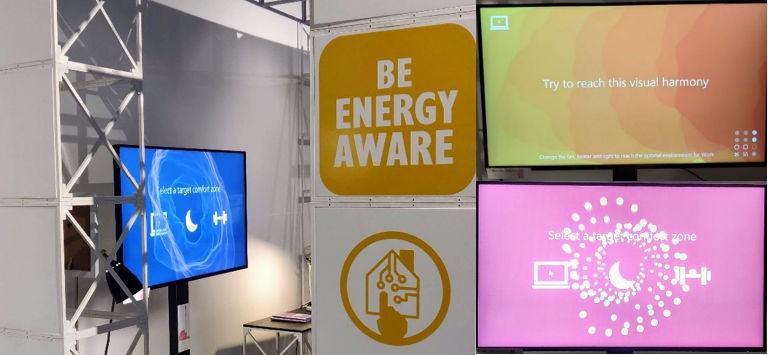Sherif Goubran is an architect and PhD candidate in the Individualized Program (INDI) at Concordia University. A Vanier scholar, he also has an MASc in building engineering from Concordia and a BS in architecture from the American University in Cairo. He co-leads a food preservation project on campus and represents graduate students on a number of university committees.
You walk into your home. It already knows you were on the way. It had set the thermometer to the temperature you most likely would have chosen. It lights up your entrance and prepares your kitchen for cooking dinner.
You don’t know that your home had adjusted its energy use during the afternoon as part of its demand response system. As a result, it decided to postpone your laundry for a few hours, lower the temperature a few more degrees, as well as the ventilation rates. It switched off your night light and closed the curtains to make sure energy doesn’t seep out of your glass windows.
But of course, your house made sure everything was in order before you got to the front door.
You finish eating your dinner and walk towards your reclining chair. This simple decision triggers a number of actions — the house now knows you will be getting back to your book. It turns on your reading light and starts your kettle in preparation for your hot chocolate.
This might sound like a fantasy, but we are not too far away from such stories becoming day-to-day realities. Sophisticated building controls and operation strategies are on the rise. Today, these technologies come with different prefixes: advanced, smart, predictive, occupant centred, etc.
Energy and emissions reduction goals, first propagated during the 1973 oil crisis, continue to place importance on consumption optimization and energy waste reduction. Energy Infrastructure and grid limitations push researchers toward examining tactics to control energy demand — especially during peak hours. Today, the promise of higher human satisfaction and improved worker productivity is driving the new focus on occupant comfort and well-being, especially in offices and commercial spaces.
Thanks to a greater range of sensing technologies, we now have systems that are able to control indoor spaces in order to meet occupant needs while minimizing energy consumption. Some spaces already monitor your behaviour, know your preferences and, in many cases, even predict your comfort needs.
Are our interactions with building controls a good measure of comfort?
One of the underlying assumptions in building controls is that people’s interactions with the building systems are a proxy or signal of discomfort. This assumption is true in many cases if we consider humans as comfort-seeking beings. However, we also know that it is not that simple and that people have different comfort priorities and responses to discomfort.
The summary of the available research tells us that there is A LOT of variations in preferences related to comfort. Some researchers indicate that these differences are sometimes due to gender, culture and external environmental factors, such as if you already feel cold or hot walking into a space.
In informal discussions — not necessarily scientifically published — age and biological factors were also mentioned as a variable that affects comfort level in relation to temperature (people who experience hot flashes might change temperature settings without any external triggers) and lighting levels (people with vision problems — such as cataracts — might require more light.
Based on personal experience, I can assume that perception and conditioning might play a role. For example, my lab space at Concordia always feels cold. But the thermostat’s reading is always above 20ºC, which is higher than at my house. Now, I feel like I get cold just by stepping into this space.
We also know that people don’t always use building controls the way designers intended. Kempton tells us that by investigating an individual’s temperature and thermostat settings at home, “people routinely develop their own theories to explain the world around them” — including how their thermostat works. Previous experiences influence these theories and can be “inconsistent with the [correct] engineering knowledge.”
The fact that a lot of the thermostats in public and/or commercial buildings are dummy controls makes for a good example. While the illusion of temperature control might make people feel a little more comfortable, it also puts into question the effectiveness of building controls altogether.
In a recent article published in ASHRAE Transactions, the author cites how failed improvements to an HVAC system in a Canadian public research building pushed users to utilize individual space heaters, which in turn augmented the building’s systems’ “misbehaviour,” including putting the building’s system in cooling mode during winter.
A walk across some of Concordia’s own buildings — where thermostats sometimes don’t fully respond to occupants’ inputs — provides an illustrative example of how people will avoid building controls altogether and resort to using personal solutions such as heaters and fans.
But what if … the problem was our own comfort preferences?
The ethos of occupant-centred control is rooted in the feedback received by occupants. By collecting data about temperature, light and ventilation preferences of users over a long period of time, models develop controls for indoor environments based on occupant behaviour. By estimating usage patterns and occupant preferences, the modern building automation system can achieve a user-defined “comfort” at the lowest energy cost. However, comfort preferences are generally not put into question.
After highlighting the plasticity of human temperature acclimation, Just et al. ask in their recently published article, “why do humans expend such extraordinary expense to maintain constant indoor climates when such climates are not necessary for survival?”
When I visited the UAE, I had to constantly wear jackets in indoor spaces during the blazing summer months. Some people are comfortable sleeping with their air conditioner at 16ºC during the summer. I’ve visited homes in Montreal where the occupant’s winter preferences were above 27º C during winter — during both day and night — because they are “more comfortable in a T-shirt and shorts.”
In European countries, or even Cairo, Egypt, where I come from, it is a “normal” behaviour to wear a heavy sweater at home during winter or to wear less clothing in the summer to combat the heat. I never expected indoor spaces to have exactly the right temperature in order to be “comfortable.”
The real question we have to ask is whether the comfort level dictated by occupants is rational, considerate or sustainable?
We know that people’s own perceived comfort can be steered by other motives beyond their physical or biological well-being, including resource-saving.
Can an automated urban future lead to disengaged and ill-informed occupants?
Due to the novelty of this topic, the social implications of automation, including occupant disengagement, hasn’t been studied yet. However, research already tells us that the more disengaged an individual is from the consequences of their energy choices, the less likely they will make energy-wise decisions. And, we know that simple and non-technological engagement mechanisms can yield positive outcomes in terms of educating users and influencing their behaviours.
In occupant-building interaction, reports and data provided through apps or displays have been previously used to inform occupants about energy consumption and the effects of their actions. Reports show that real-time eco-feedback and gamification are effective means for raising awareness of the energy consequences of occupants’ actions and possibly changing behaviours.
Until now, most eco-feedback depended on direct data reporting, such as energy consumption metrics or savings metrics, or direct messages, such as red indicators for high usage and green indicators for eco-usage.
But what if we can create highly engaging and real-time responsive games to help occupants make energy-wise decisions?
What happens if we move away from the excessive quantitative energy measures, CO2 equivalent graphs, the green/red indicators, the green leaves and the energy stars?
Can abstracted non-environmentally-centred visuals help occupants make energy responsible choices?
At IDEAS-BE, led by Carmela Cucuzzella, we have been exploring these questions within a project that studies eco-teaching in the built environment — here’s a preview of a recent project publication. Our aim is to investigate new ways that can help residents picture their indoor spaces using artistic visuals that are engaging and stimulating. We have come up with an approach that moves away from automation and environmental clichés.
 © Anghelos Coulon and IDEAS-BE
© Anghelos Coulon and IDEAS-BE
The installation we put together provides the possibility for soliciting desired occupants-building interaction in real-time at an individual equipment level. At IDEAS-BE, we believe that the future of “smart” built spaces relies on “smart” occupants — who are engaged, well informed and critical in their decisions.
IDEAS-BE invites you to try their installation at Concordia’s 4TH SPACE on the ground floor of the J.W. McConnell (LB) Building and provide feedback.
About the author



 Image by
Image by